Bibliometric and Visualization Analysis of Groundwater Heavy Metal Pollution Research Based on Web of Science
Abstract
1. Introduction
2. Materials and Methods
2.1. Data Source
2.2. Analytical Method
3. Results and Analysis
3.1. Number of Publications
3.2. Main Published Journals
3.3. Main Countries and Regions
3.4. Major Research Institutions
3.5. Paper Citations
3.5.1. Co-Cited Articles
3.5.2. Highly Cited Papers
3.6. Research Hotspot in the Future Development Trend
3.6.1. Keyword Analysis
3.6.2. Keywords Cluster
3.6.3. Burst Terms
4. Summary and Outlook
Author Contributions
Funding
Data Availability Statement
Acknowledgments
Conflicts of Interest
References
- Jiang, J.; Han, D.; Xiao, Y.; Song, X. Occurrence, Migration, and Assessment of Human Health and Ecological Risks of PFASs and EDCs in Groundwater of Northeast China. Water Res. 2025, 269, 122810. [Google Scholar] [CrossRef] [PubMed]
- Deng, J.; Yang, G.; Yan, X.; Du, J.; Tang, Q.; Yu, C.; Pu, S. Quality Evaluation and Health Risk Assessment of Karst Groundwater in Southwest China. Sci. Total Environ. 2024, 946, 174371. [Google Scholar] [CrossRef] [PubMed]
- Saha, N.; Rahman, M.S.; Ahmed, M.B.; Zhou, J.L.; Huu, H.N.; Guo, W. Industrial Metal Pollution in Water and Probabilistic Assessment of Human Health Risk. J. Environ. Manag. 2017, 185, 70–78. [Google Scholar] [CrossRef] [PubMed]
- Yan, B.; Wei, Q.; Li, X.; Song, X.; Gao, Z.; Liu, J.; Zhang, R.; Wang, M. Heavy Metal Content Characteristics and Pollution Source Analysis of Shallow Groundwater in Tengzhou Coal Mining Area. Water 2023, 15, 4091. [Google Scholar] [CrossRef]
- Lin, Z.; Chen, H.; Yang, H. Risk of Contamination of Infiltrated Water and Underground Soil by Heavy Metals within a Ceramic Permeable Brick Paving System. Environ. Sci. Pollut. Res. 2020, 27, 22795–22805. [Google Scholar] [CrossRef]
- Pan, Y.; Peng, H.; Hou, Q.; Peng, K.; Shi, H.; Wang, S.; Zhang, W.; Zeng, M.; Huang, C.; Xu, L.; et al. Priority Control Factors for Heavy Metal Groundwater Contamination in Peninsula Regions Based on Source-Oriented Health Risk Assessment. Sci. Total Environ. 2023, 894, 165062. [Google Scholar] [CrossRef]
- Zhao, B.; Bi, B.; Lu, S.; Liu, X.; Ni, B. Occurrence and Risk Assessment of Heavy Metals in Urban Water Systems of Beijing, China. Desalin. Water Treat. 2020, 208, 312–321. [Google Scholar] [CrossRef]
- Liang, H.; Zhang, Y.; Du, S.; Cao, J.; Liu, Y.; Zhao, H.; Ding, T. Heavy Metals in Sediments of the River-Lake System in the Dianchi Basin, China: Their Pollution, Sources, and Risks. Sci. Total Environ. 2024, 957, 177652. [Google Scholar] [CrossRef]
- French, D.W.; Schindler, D.E.; Brennan, S.R.; Holtgrieve, G.W. Watershed Features Shape Spatial Patterns of Fish Tissue Mercury in a Boreal River Network. Sci. Total Environ. 2024, 945, 174060. [Google Scholar] [CrossRef]
- Khatri, N.; Tyagi, S. Influences of Natural and Anthropogenic Factors on Surface and Groundwater Quality in Rural and Urban Areas. Front. Life Sci. 2015, 8, 23–39. [Google Scholar] [CrossRef]
- Singh, U.K.; Kumar, B. Pathways of Heavy Metals Contamination and Associated Human Health Risk in Ajay River Basin, India. Chemosphere 2017, 174, 183–199. [Google Scholar] [CrossRef] [PubMed]
- Kurniawan, T.A.; Lo, W.; Liang, X.; Goh, H.H.; Othman, M.H.D.; Chong, K.-K.; Chew, K.W. Remediation Technologies for Contaminated Groundwater Due to Arsenic (As), Mercury (Hg), and/or Fluoride (F): A Critical Review and Way Forward to Contribute to Carbon Neutrality. Sep. Purif. Technol. 2023, 314, 123474. [Google Scholar] [CrossRef]
- Masoud, M.; El Osta, M.; Al-Amri, N.; Niyazi, B.; Alqarawy, A.; Halawani, R.; Rashed, M. Groundwater Recharge Evaluation Using Stable Isotopes and the NETPATH Model in Al-Madinah Al-Munawarah Province, Saudi Arabia. Water 2025, 17, 211. [Google Scholar] [CrossRef]
- Gendy, E.A.; Ifthikar, J.; Ali, J.; Oyekunle, D.T.; Elkhlifia, Z.; Shahib, I.I.; Khodair, A.I.; Chen, Z. Removal of Heavy Metals by Covalent Organic Frameworks (COFs): A Review on Its Mechanism and Adsorption Properties. J. Environ. Chem. Eng. 2021, 9, 105687. [Google Scholar] [CrossRef]
- Li, Z.; Wang, L.; Qin, L.; Lai, C.; Wang, Z.; Zhou, M.; Xiao, L.; Liu, S.; Zhang, M. Recent Advances in the Application of Water-Stable Metal-Organic Frameworks: Adsorption and Photocatalytic Reduction of Heavy Metal in Water. Chemosphere 2021, 285, 131432. [Google Scholar] [CrossRef]
- Zukauskas, S.; Rucinskiene, A.; Ramanavicius, S.; Popov, A.; Niaura, G.; Baginskiy, I.; Zahorodna, V.; Dukhnovskiy, S.; Gogotsi, O.; Ramanavicius, A. Electrochemical Real-Time Sensor for the Detection of Pb(II) Ions Based on Ti3C2Tx MXene. Sci. Total Environ. 2024, 950, 175190. [Google Scholar] [CrossRef]
- Yang, X.; Yao, L.; Yu, S.; Mu, T.; Hu, Y.; He, X.; Cheng, Y.; Xu, Z. High Stability Hydrogel Magnetic Relaxation Switch Sensor Driven by pH for the Sensitive Detection of Cd2. Anal. Chem. 2024, 96, 15598–15607. [Google Scholar] [CrossRef]
- Zhang, Y.; Lu, X.; Deng, S.; Zhu, T.; Yu, B. Bibliometric and Visual Analysis of Heavy Metal Health Risk Assessment: Development, Hotspots and Trends. Arch. Environ. Prot. 2024, 50, 56–71. [Google Scholar] [CrossRef]
- Introduction. UNECE. Available online: https://unece.org/environment-policy/water/about-the-convention/introduction (accessed on 19 March 2025).
- US EPA. America’s Water Infrastructure Act of 2018 (AWIA). Available online: https://www.epa.gov/ground-water-and-drinking-water/americas-water-infrastructure-act-2018-awia (accessed on 19 March 2025).
- Notice of The State Council on Printing and Issuing Action Plan for Water Pollution Prevention and Control_Environmental Monitoring, Protection and Control_ Chinese Government Website. Available online: https://www.gov.cn/zhengce/content/2015-04/16/content_9613.htm (accessed on 15 March 2025).
- Liu, K.; Guan, X.; Li, C.; Zhao, K.; Yang, X.; Fu, R.; Li, Y.; Yu, F. Global Perspectives and Future Research Directions for the Phytoremediation of Heavy Metal-Contaminated Soil: A Knowledge Mapping Analysis from 2001 to 2020. Front. Environ. Sci. Eng. 2022, 16, 73. [Google Scholar] [CrossRef]
- Lai, Y.; Jiang, J.; Zhang, H.; Gong, K. Bibliometric Analysis of Curcumin Based on CiteSpace: Landscapes, Hotspots, and Frontiers. Drug Des. Dev. Ther. 2024, 18, 5743–5758. [Google Scholar] [CrossRef]
- Zhang, D.; Bai, F. Research Trends and Hotspots in the Immune Microenvironment Related to Hepatocellular Carcinoma: A Bibliometric and Visualization Study. World J. Gastrointest. Oncol. 2024, 16, 3321–3330. [Google Scholar] [CrossRef] [PubMed]
- U.S. Environmental Protection Agency. Summary of the Clean Water Act. Available online: https://www.epa.gov/laws-regulations/summary-clean-water-act (accessed on 19 March 2025).
- U.S. Environmental Protection Agency. Use of Lead Free Pipes, Fittings, Fixtures, Solder, and Flux for Drinking Water. Available online: https://www.epa.gov/sdwa/use-lead-free-pipes-fittings-fixtures-solder-and-flux-drinking-water (accessed on 19 March 2025).
- National Water Policy 2012. UNEP Law and Environment Assistance Platform. Available online: https://leap.unep.org/en/countries/in/national-legislation/national-water-policy-2012 (accessed on 19 March 2025).
- Namami Gange Programme. Available online: https://nmcg.nic.in/NamamiGanga.aspx (accessed on 19 March 2025).
- Piper, A.M. A Graphic Procedure in the Geochemical Interpretation of Water-Analyses. Eos Trans. Am. Geophys. Union 1944, 25, 914–928. [Google Scholar] [CrossRef]
- Li, Z.; Ma, Z.; Van Der Kuijp, T.J.; Yuan, Z.; Huang, L. A Review of Soil Heavy Metal Pollution from Mines in China: Pollution and Health Risk Assessment. Sci. Total Environ. 2014, 468–469, 843–853. [Google Scholar] [CrossRef] [PubMed]
- Smedley, P.L.; Kinniburgh, D.G. A Review of the Source, Behaviour and Distribution of Arsenic in Natural Waters. Appl. Geochem. 2002, 17, 517–568. [Google Scholar] [CrossRef]
- Hakanson, L. An Ecological Risk Index for Aquatic Pollution Control.a Sedimentological Approach. Water Res. 1980, 14, 975–1001. [Google Scholar] [CrossRef]
- Walkley, A.; Black, I.A. An Examination of the Degtjareff Method for Determining Soil Organic Matter, and a Proposed Modification of the Chromic Acid Titration Method. Soil Sci. 1934, 37, 29. [Google Scholar] [CrossRef]
- Backman, B.; Bodis, D.; Lahermo, P.; Rapant, S.; Tarvainen, T. Application of a Groundwater Contamination Index in Finland and Slovakia. Environ. Geol. 1998, 36, 55–64. [Google Scholar] [CrossRef]
- Liu, C.W.; Lin, K.H.; Kuo, Y.M. Application of Factor Analysis in the Assessment of Groundwater Quality in a Blackfoot Disease Area in Taiwan. Sci. Total Environ. 2003, 313, 77–89. [Google Scholar] [CrossRef]
- Mohan, D.; Pittman, C.U. Arsenic Removal from Water/Wastewater Using Adsorbents-A Critical Review. J. Hazard. Mater. 2007, 142, 1–53. [Google Scholar] [CrossRef]
- Mandal, B.K.; Suzuki, K.T. Arsenic Round the World: A Review. Talanta 2002, 58, 201–235. [Google Scholar] [CrossRef]
- Xiao, J.; Wang, L.; Deng, L.; Jin, Z. Characteristics, Sources, Water Quality and Health Risk Assessment of Trace Elements in River Water and Well Water in the Chinese Loess Plateau. Sci. Total Environ. 2019, 650, 2004–2012. [Google Scholar] [CrossRef] [PubMed]
- Turekian, K.K.; Wedepohl, K.H. Distribution of the Elements in Some Major Units of the Earth’s Crust. Bull. Geol. Soc. Am. 1961, 72, 175–192. [Google Scholar]
- Mohan, S.V.; Nithila, P.; Reddy, S.J. Estimation of Heavy Metals in Drinking Water and Development of Heavy Metal Pollution Index. J. Environ. Sci. Heal. A Environ. Sci. Eng. Toxicol. 1996, 31, 283–289. [Google Scholar] [CrossRef]
- Prasad, B.; Bose, J.M. Evaluation of the Heavy Metal Pollution Index for Surface and Spring Water near a Limestone Mining Area of the Lower Himalayas. Environ. Geol. 2001, 41, 183–188. [Google Scholar] [CrossRef]
- Edet, A.E.; Offiong, O.E. Evaluation of Water Quality Pollution Indices for Heavy Metal Contamination Monitoring. A Study Case from Akpabuyo-Odukpani Area, Lower Cross River Basin (Southeastern Nigeria). GeoJournal 2002, 57, 295–304. [Google Scholar] [CrossRef]
- Järup, L. Hazards of Heavy Metal Contamination. Br. Med. Bull. 2003, 68, 167–182. [Google Scholar] [CrossRef]
- Muhammad, S.; Shah, M.T.; Khan, S. Health Risk Assessment of Heavy Metals and Their Source Apportionment in Drinking Water of Kohistan Region, Northern Pakistan. Microchem. J. 2011, 98, 334–343. [Google Scholar] [CrossRef]
- Khan, S.; Cao, Q.; Zheng, Y.M.; Huang, Y.Z.; Zhu, Y.G. Health Risks of Heavy Metals in Contaminated Soils and Food Crops Irrigated with Wastewater in Beijing, China. Environ. Pollut. 2008, 152, 686–692. [Google Scholar] [CrossRef]
- Lim, H.; Lee, J.; Chon, H.; Sager, M. Heavy Metal Contamination and Health Risk Assessment in the Vicinity of the Abandoned Songcheon Au-Ag Mine in Korea. J. Geochem. Explor. 2008, 96, 223–230. [Google Scholar] [CrossRef]
- Wongsasuluk, P.; Chotpantarat, S.; Siriwong, W.; Robson, M. Heavy Metal Contamination and Human Health Risk Assessment in Drinking Water from Shallow Groundwater Wells in an Agricultural Area in Ubon Ratchathani Province, Thailand. Environ. Geochem. Health 2014, 36, 169–182. [Google Scholar] [CrossRef]
- Muller, G. Index of Geoaccumulation in Sediments of the Rhine River. GeoJournal 1969, 2, 109–118. [Google Scholar]
- Rattan, R.K.; Datta, S.P.; Chhonkar, P.K.; Suribabu, K.; Singh, A.K. Long-Term Impact of Irrigation with Sewage Effluents on Heavy Metal Content in Soils, Crops and Groundwater—A Case Study. Agric. Ecosyst. Environ. 2005, 109, 310–322. [Google Scholar] [CrossRef]
- Gibbs, R.J. Mechanisms Controlling World Water Chemistry. Science 1970, 170, 1088–1090. [Google Scholar] [CrossRef]
- Wang, J.; Liu, G.; Liu, H.; Lam, P.K.S. Multivariate Statistical Evaluation of Dissolved Trace Elements and a Water Quality Assessment in the Middle Reaches of Huaihe River, Anhui, China. Sci. Total Environ. 2017, 583, 421–431. [Google Scholar] [CrossRef]
- Wu, B.; Zhao, D.Y.; Jia, H.Y.; Zhang, Y.; Zhang, X.X.; Cheng, S.P. Preliminary Risk Assessment of Trace Metal Pollution in Surface Water from Yangtze River in Nanjing Section, China. Bull. Environ. Contam. Toxicol. 2009, 82, 405–409. [Google Scholar] [CrossRef]
- Kjeldsen, P.; Barlaz, M.A.; Rooker, A.P.; Baun, A.; Ledin, A.; Christensen, T.H. Present and Long-Term Composition of MSW Landfill Leachate: A Review. Crit. Rev. Environ. Sci. Technol. 2002, 32, 297–336. [Google Scholar] [CrossRef]
- Tomlinson, D.L.; Wilson, J.G.; Harris, C.R.; Jeffrey, D.W. Problems in the Assessment of Heavy-Metal Levels in Estuaries and the Formation of a Pollution Index. Helgol. Meeresunters 1980, 33, 566–575. [Google Scholar] [CrossRef]
- Ho, Y.S.; McKay, G. Pseudo-Second Order Model for Sorption Processes. Process Biochem. 1999, 34, 451–465. [Google Scholar] [CrossRef]
- Hashim, M.A.; Mukhopadhyay, S.; Sahu, J.N.; Sengupta, B. Remediation Technologies for Heavy Metal Contaminated Groundwater. J. Environ. Manag. 2011, 92, 2355–2388. [Google Scholar] [CrossRef]
- Mulligan, C.N.; Yong, R.N.; Gibbs, B.F. Remediation Technologies for Metal-Contaminated Soils and Groundwater: An Evaluation. Eng. Geol. 2001, 60, 193–207. [Google Scholar] [CrossRef]
- Fu, F.; Wang, Q. Removal of Heavy Metal Ions from Wastewaters: A Review. J. Environ. Manag. 2011, 92, 407–418. [Google Scholar] [CrossRef] [PubMed]
- Tessier, A.P.; Campbell, P.G.C.; Bisson, M.X. Sequential Extraction Procedure for the Speciation of Particulate Trace Metals. Anal. Chem. 1979, 51, 844–851. [Google Scholar] [CrossRef]
- Bridgewater, L.; Association, A.P.H.; Association, A.W.W.; Federation, W.E. Standard Methods for the Examination of Water and Wastewater; American Public Health Association: Washington, DC, USA, 2012; ISBN 978-0-87553-013-0. [Google Scholar]
- Langmuir, I. THE ADSORPTION OF GASES ON PLANE SURFACES OF GLASS, MICA AND PLATINUM. J. Am. Chem. Soc. 1918, 40, 1361–1403. [Google Scholar] [CrossRef]
- Jacobs, H.L.; Gabrielson, I.N.; Horton, R.K.; Lyon, W.A.; Hubbard, E.C.; McCallum, G.E. Water Quality Criteria-Stream vs. Effluent Standards. J. Water Pollut. Control Fed. 1965, 37, 292–315. [Google Scholar]
- Gorchev, H.G.; Ozolins, G. WHO Guidelines for Drinking-Water Quality. WHO Chron. 1984, 38, 104–108. [Google Scholar]
- Dong, Y.; Kong, X.; Luo, X.; Wang, H. Adsorptive Removal of Heavy Metal Anions from Water by Layered Double Hydroxide: A Review. Chemosphere 2022, 303, 134685. [Google Scholar] [CrossRef]
- Abdel-Mohsen, H.A.; Ismail, M.M.; Moussa Moussa, R. Hazardous Impacts of Heavy Metal Pollution on Biometric and Biochemical Composition of Pearl Oyster Pinctada radiata from Five Sites along Alexandria Coast, with Reference to Its Potential Health Risk Assessment. Environ. Sci. Pollut. Res. 2024, 31, 23262–23282. [Google Scholar] [CrossRef]
- Yuan, L.; Xu, M.; Zhang, Y.; Gao, Z.; Zhang, L.; Cheng, C.; Ji, C.; Hua, M.; Lv, L.; Zhang, W. Machine Learning-Assisted Screening of Metal-Organic Frameworks (MOFs) for the Removal of Heavy Metals in Aqueous Solution. Sep. Purif. Technol. 2024, 339, 126732. [Google Scholar] [CrossRef]
- He, J.; Li, C.; Tan, X.; Peng, Z.; Li, H.; Luo, X.; Tang, L.; Wei, J.; Tang, C.; Yang, W.; et al. Driving Factors for Distribution and Transformation of Heavy Metals Speciation in a Zinc Smelting Site. J. Hazard. Mater. 2024, 471, 134413. [Google Scholar] [CrossRef]
- Duan, S.; Peng, L.; Chen, W.; Kwakye, K.K.; Zhou, K.; Teng, C. Spectroscopic Insights into the Binding Characteristics of Heavy Metals to Dissolved Organic Matter in Landfill Leachate. Chemosphere 2024, 352, 141433. [Google Scholar] [CrossRef]
- Salimi, R.; Taherkhani, R. The Transition towards a Sustainable Circular Economy through Life Cycle Assessment in the Building and Construction Sector: A Review and Bibliometric Analysis. Environ. Sci. Pollut. Res. Int. 2024, 31, 62588–62622. [Google Scholar] [CrossRef]
- 2014 China Environmental Bulletin_Ministry of Ecology and Environment, PRC. Available online: https://www.mee.gov.cn/xxgk2018/xxgk/xxgk15/201912/t20191231_754085.htm (accessed on 19 March 2025).
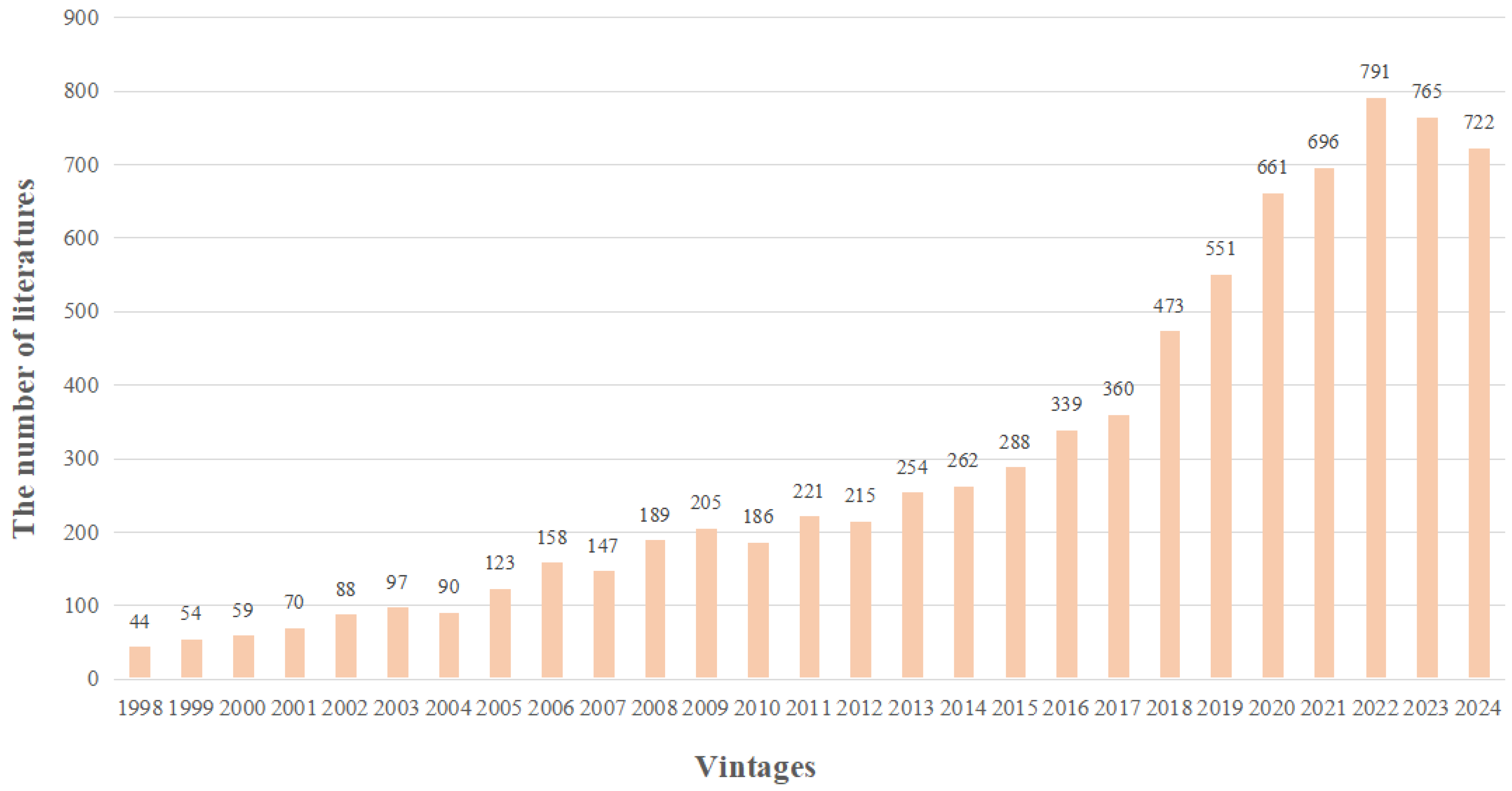
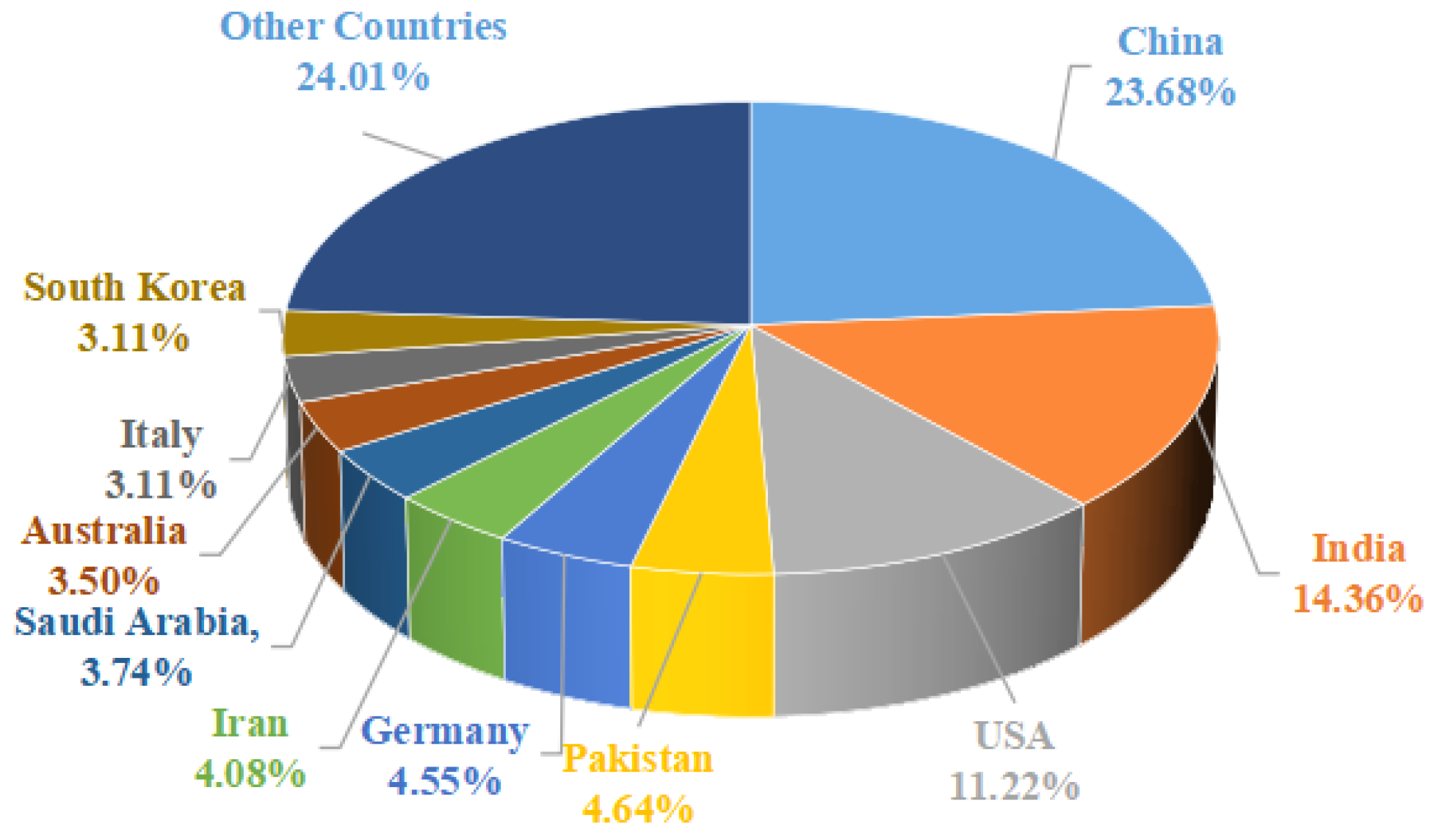
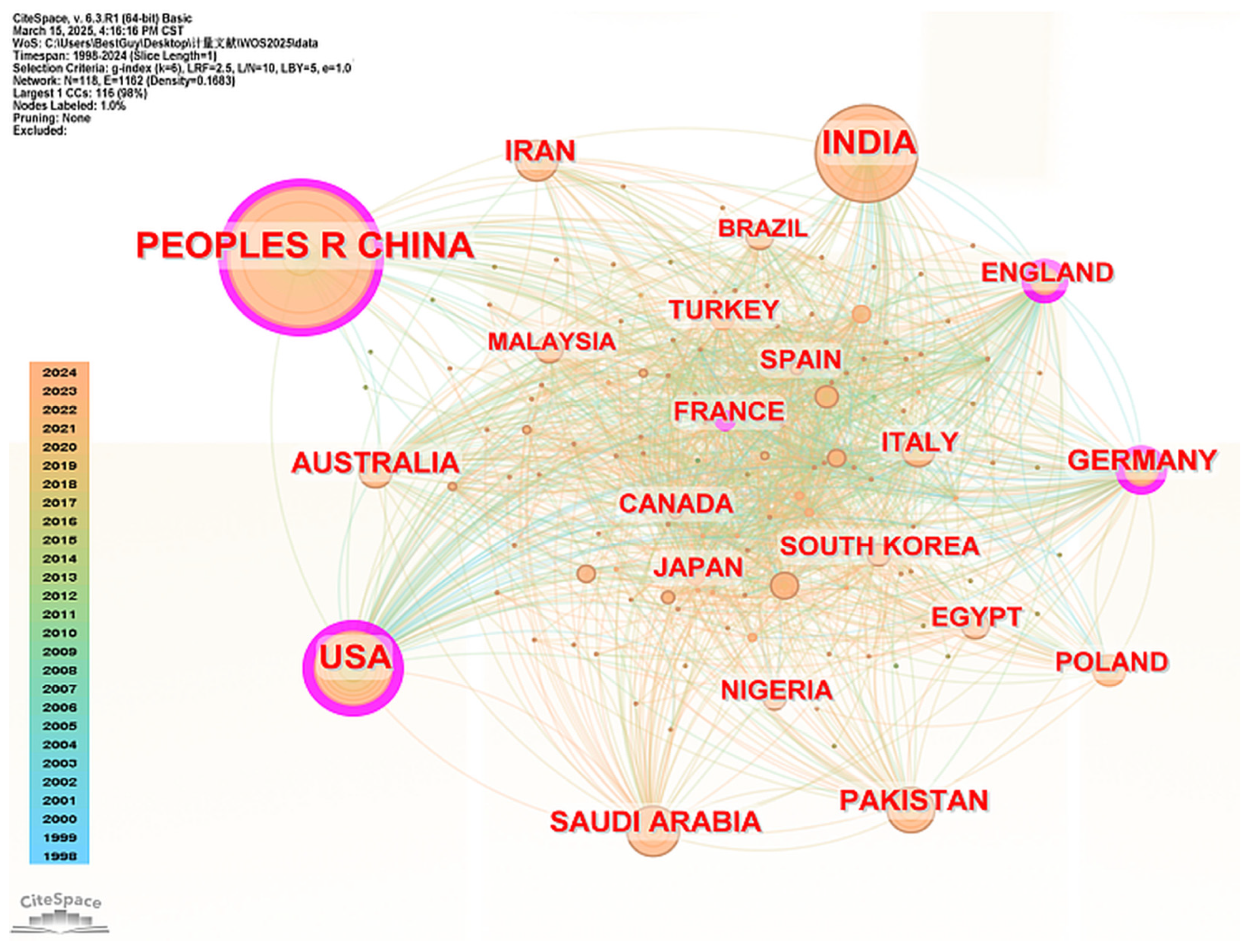

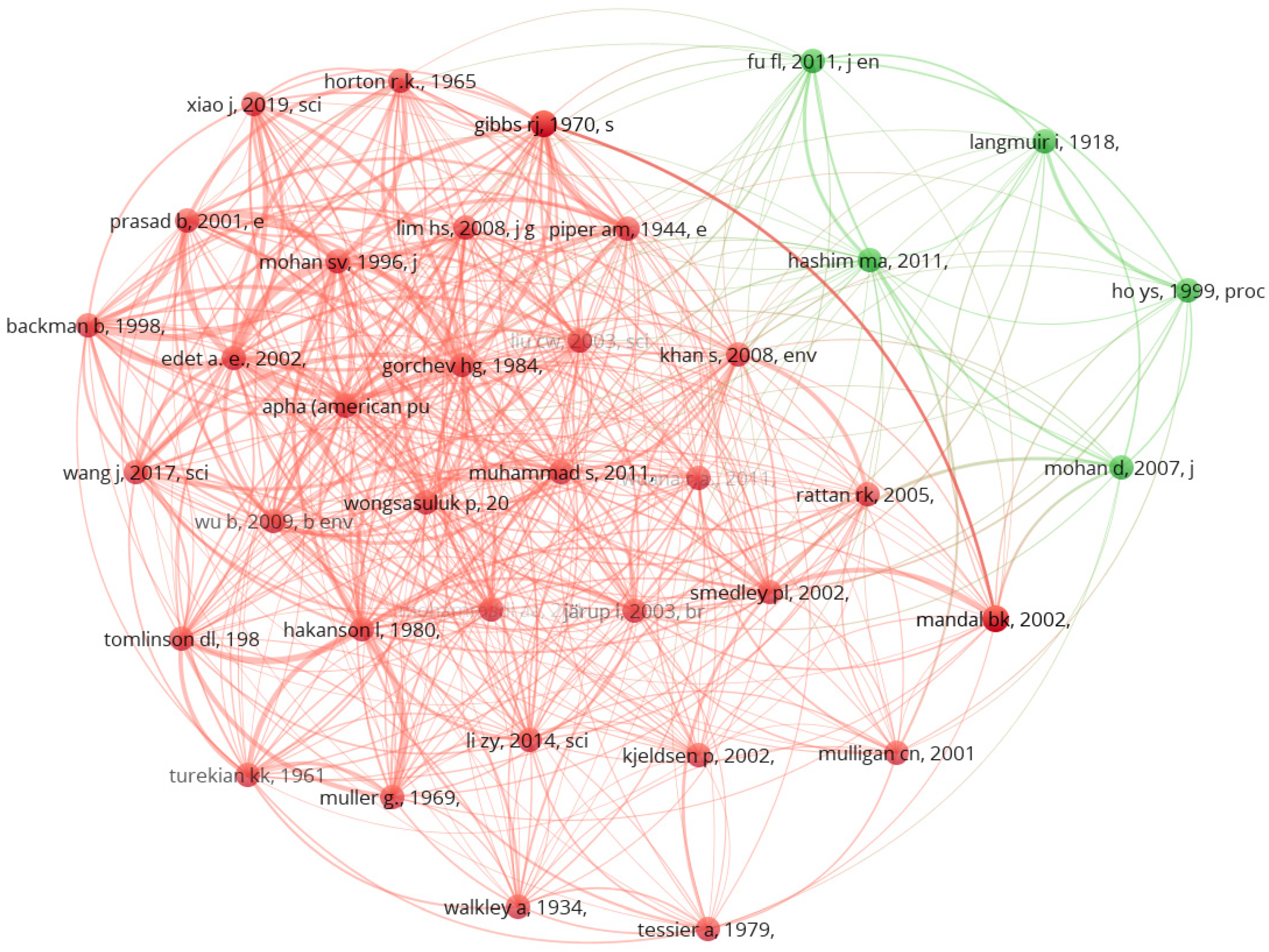

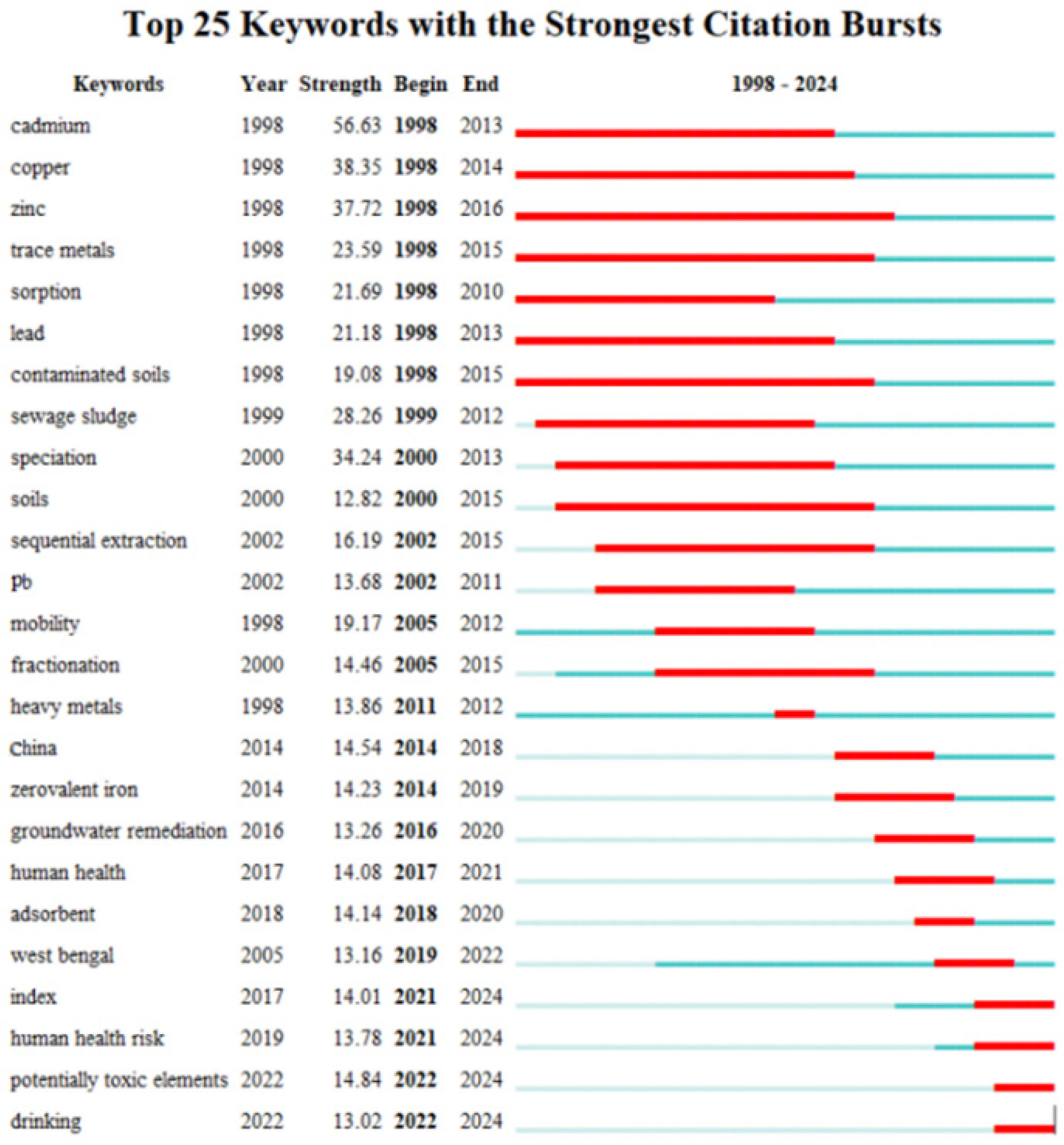
| Journal Name | TLCS | TGCS | CAS Journal Partition | Publications | IF 2023 | |
|---|---|---|---|---|---|---|
| 1 | Science of the Total Environment | 1051 | 18,827 | Q1 | 364 | 8.2 |
| 2 | Journal of Hazardous Materials | 886 | 20,576 | Q1 | 212 | 12.2 |
| 3 | Chemosphere | 683 | 11,756 | Q2 | 220 | 8.1 |
| 4 | Environmental Science and Pollution Research | 672 | 8309 | Q3 | 336 | 5.8 |
| 5 | Environmental Monitoring and Assessment | 573 | 7735 | Q4 | 249 | 2.9 |
| 6 | Environmental Geochemistry and Health | 604 | 4110 | Q3 | 150 | 3.2 |
| 7 | Journal of Environmental Management | 430 | 5993 | Q2 | 127 | 8.0 |
| 8 | Water Research | 422 | 5646 | Q1 | 71 | 11.4 |
| 9 | Environmental Pollution | 389 | 8054 | Q2 | 152 | 7.6 |
| 10 | Environmental Science & Technology | 276 | 5665 | Q1 | 62 | 10.8 |
| Rank | Research Institute | Number of Publications | Country | TLCS | TGCS |
|---|---|---|---|---|---|
| 1 | Chinese Academy of Sciences | 324 | China | 956 | 13,368 |
| 2 | Indian Institute of Technology | 205 | India | 246 | 2839 |
| 3 | CSIR India | 163 | India | 157 | 1199 |
| 4 | China University of Geosciences | 140 | China | 150 | 2196 |
| 5 | King Saud University | 133 | Saudi Arabia | 158 | 2953 |
| 6 | University of Chinese Academy of Sciences | 120 | China | 70 | 2413 |
| 7 | U.S. Department of Energy | 101 | America | 153 | 2462 |
| 8 | Centre national de la recherche scientifique | 97 | France | 53 | 1799 |
| 9 | Tongji University | 75 | China | 42 | 1998 |
| 10 | Helmholtz Association | 71 | Germany | 48 | 2002 |
| Rank | Title | Author | TLCS | TGCS | Publication Year | Source Journal |
|---|---|---|---|---|---|---|
| 1 | Health risk assessment of heavy metals and their source apportionment in drinking water of Kohistan region, northern Pakistan [44] | Said Muhammad | 147 | 505 | 2011 | Microchemical Journal |
| 2 | Heavy metal contamination and human health risk assessment in drinking water from shallow groundwater wells in an agricultural area in Ubon Ratchathani province, Thailand [47] | Pokkate Wongsasuluk | 130 | 363 | 2014 | Environmental Geochemistry and Health |
| 3 | Remediation technologies for heavy metal contaminated groundwater [56] | M.A. Hashim | 120 | 674 | 2011 | Journal of Environmental Management |
| 4 | Long-term impact of irrigation with sewage effluents on heavy metal content in soils, crops and groundwater—a case study [49] | R.K. Rattan | 116 | 721 | 2005 | Agriculture Ecosystems & Environment |
| 5 | Present and long-term composition of MSW landfill leachate: A review [53] | Peter Kjeldsen | 112 | 1692 | 2002 | Critical Reviews in Environmental Science and Technology |
| Rank | Centrality | Keywords | Frequency |
|---|---|---|---|
| 1 | 1.58 | zinc | 346 |
| 2 | 0.98 | copper | 288 |
| 3 | 0.84 | lead | 365 |
| 4 | 0.64 | sewage sludge | 164 |
| 5 | 0.63 | accumulation | 370 |
| 6 | 0.58 | phytoremediation | 97 |
| 7 | 0.57 | removal | 698 |
| 8 | 0.57 | Cd | 80 |
| 9 | 0.47 | Pb | 127 |
| 10 | 0.47 | elements | 114 |
| 11 | 0.46 | water | 909 |
| 12 | 0.39 | trace metals | 262 |
| 13 | 0.38 | soils | 354 |
| 14 | 0.37 | sediments | 432 |
| 15 | 0.37 | reduction | 196 |
Disclaimer/Publisher’s Note: The statements, opinions and data contained in all publications are solely those of the individual author(s) and contributor(s) and not of MDPI and/or the editor(s). MDPI and/or the editor(s) disclaim responsibility for any injury to people or property resulting from any ideas, methods, instructions or products referred to in the content. |
© 2025 by the authors. Licensee MDPI, Basel, Switzerland. This article is an open access article distributed under the terms and conditions of the Creative Commons Attribution (CC BY) license (https://creativecommons.org/licenses/by/4.0/).
Share and Cite
Xie, Y.; Jia, W.; Tan, M.; Feng, Y.; Fu, S.; Zhang, D. Bibliometric and Visualization Analysis of Groundwater Heavy Metal Pollution Research Based on Web of Science. Water 2025, 17, 942. https://doi.org/10.3390/w17070942
Xie Y, Jia W, Tan M, Feng Y, Fu S, Zhang D. Bibliometric and Visualization Analysis of Groundwater Heavy Metal Pollution Research Based on Web of Science. Water. 2025; 17(7):942. https://doi.org/10.3390/w17070942
Chicago/Turabian StyleXie, Yizhen, Wenchao Jia, Min Tan, Yu Feng, Shijun Fu, and Dongdong Zhang. 2025. "Bibliometric and Visualization Analysis of Groundwater Heavy Metal Pollution Research Based on Web of Science" Water 17, no. 7: 942. https://doi.org/10.3390/w17070942
APA StyleXie, Y., Jia, W., Tan, M., Feng, Y., Fu, S., & Zhang, D. (2025). Bibliometric and Visualization Analysis of Groundwater Heavy Metal Pollution Research Based on Web of Science. Water, 17(7), 942. https://doi.org/10.3390/w17070942





